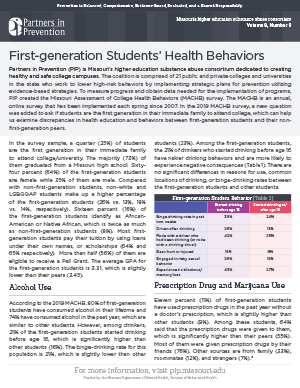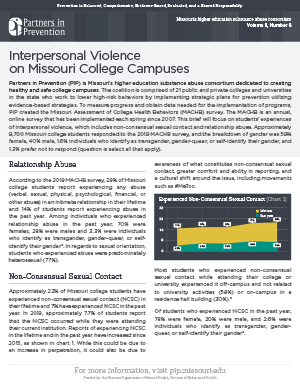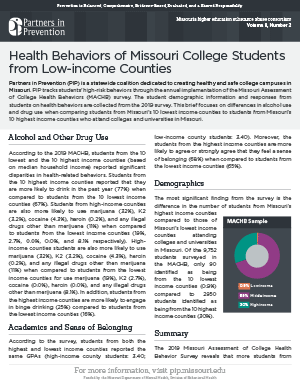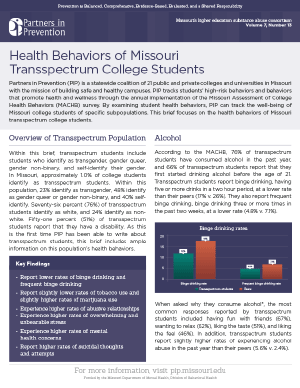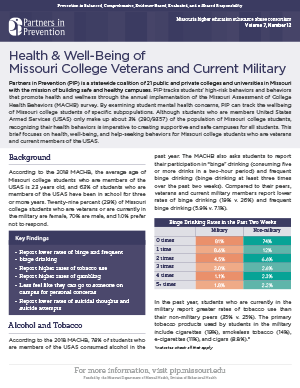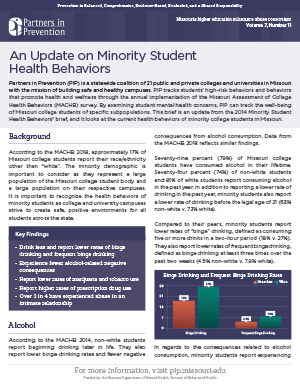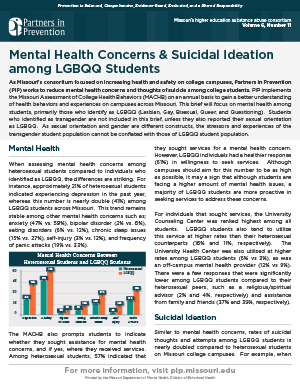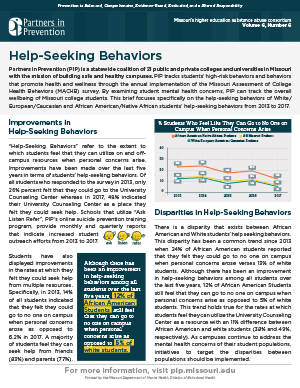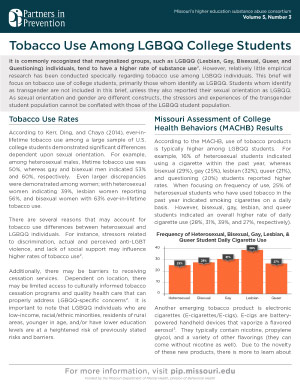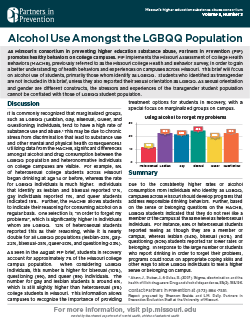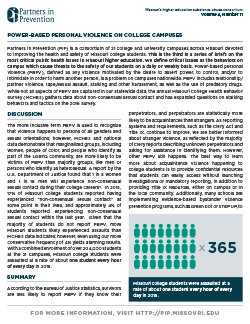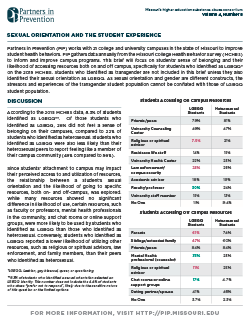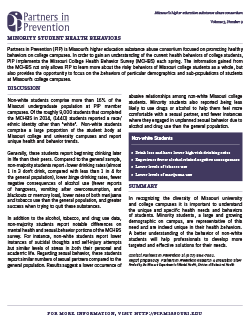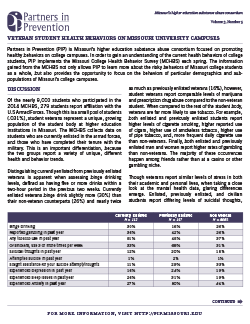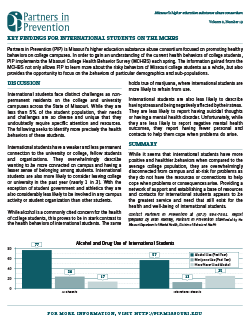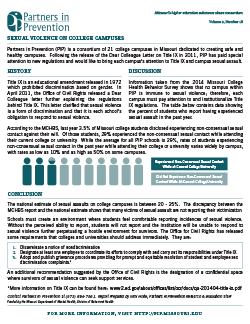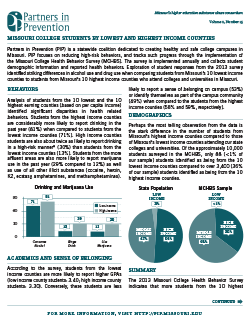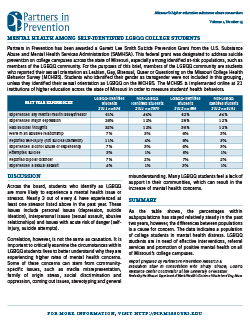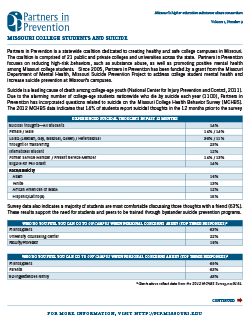
Prevention and Health Equity

Prevention is a justice and equity issue.
Certain communities and populations are impacted differently by substance misuse, mental health concerns, and interpersonal violence on college campuses and throughout their lifetime. It is vital that prevention be culturally competent, trauma-informed, intersectional, and address structural issues and barriers. Compiled here is information about existing health inequities and resources for ways to improve our work. This is not an exhaustive list and will continue to be updated.
- Scope
- Intersectionality
- Data Briefs
- Best Practices
- National Resources
- Missouri Resources
- PIP Resources
- Research
Scope
Quick Links
International Students | LGBQQ+ Students | Students with Disabilities | Students who have Experienced ACEs | Students with Low SES | Students of Color | Veteran Students | Women and Transspectrum Students | Other ConsiderationsInternational Students
Alcohol and Other Drug Use
- International students may be at additional risk of AOD misuse due to a major lifestyle change (being away from home/friends/family/support system), stress, culture shock, homesickness, and more. Additional peer pressure and wanting to fit in can also contribute to reasons students misuse17
Interpersonal Violence
- There is relatively little research on the experiences of interpersonal violence among international students, but stigma about interpersonal violence, lack of knowledge of resources, language barriers, and concerns about visa or citizenship status may be reasons that international students do not seek help or confront additional struggles when experiencing interpersonal violence
Mental Health and Suicide
- While international students are not necessarily more at risk of developing mental health concerns, they may be less likely to seek mental health services due to a variety of factors (language barrier, stigma in home country of mental health, less awareness of resources, etc.)18
- International students also have unique stressors that might play into their mental health concerns (language barriers, acculturative stress, concerns about family or home country, limited social support, etc.)18
- These additional stressors on mental health can also be risk factors for suicide, especially coupled with depression (or family history), experiences of prejudice and/or discrimination, etc.
LGBQQ+ Students
Alcohol and Other Drug Misuse
- Sexual minority students are at a higher risk for substance misuse and dependency than heterosexual students1
Interpersonal Violence
- 44% of lesbians and 61% of bisexual women experience rape, physical violence, or stalking by an intimate partner, compared to 35% of straight women9
- 26%of gay men and 37% of bisexual men experience rape, physical violence, or stalking by an intimate partner, compared to 29% of straight men9
Mental Health and Suicide
- LGB adults are more than twice as likely as heterosexual adults to experience a mental health condition16
- LGB youth seriously contemplate suicide at almost three times the rate of heterosexual youth15
- LGB youth are almost five times as likely to have attempted suicide compared to heterosexual youth15
Students with Disabilities
Alcohol and Other Drug Misuse
- Students with disabilities are not necessarily more likely to misuse substances than students without disabilities, but co-occurring mental health concerns, using substances to cope, and using substances to manage pain may be more prevalent among students with disabilities as reasons they misuse substances19
Interpersonal Violence
- People with disabilities have a higher lifetime prevalence of experiencing abuse than people without disabilities20
- People with disabilities are three times as likely to be sexually assaulted as their peers without disabilities20
Mental Health and Suicide
- Studies have shown that symptoms of depression may be 2 to 10 times more common in individuals with disabilities or chronic illnesses, and depression is one of the most common “secondary conditions” associated with disability and chronic illness21
- Adults with learning disabilities had 46% higher odds of having attempted suicide than their peers without learning problems22
Students who have Experienced Trauma/Adverse Childhood Experiences (ACEs)
Note: Females and several racial/ethnic minority groups were at greater risk for experiencing 4 or more ACEs10
Alcohol and Other Drug Misuse
- Students who have experienced trauma or have a higher score on the ACEs (experiences including abuse/neglect/other trauma) experience higher rates of substance use and addiction into adulthood7
Mental Health and Suicide
- Research shows that lower ACEs scores are correlated with lower instances of depression and other health conditions10
Students with Low-income/Low Socio-economic Status (SES)
Alcohol and Other Drug Use
- Individuals from low socio-economic areas may be more likely to use tobacco/nicotine products23
Interpersonal Violence
- Although exposure to violence affects all SES groups, youth from lower SES backgrounds tend to have increased exposure and likelihood of suffering from detrimental violence25
Mental Health and Suicide
- Children and adolescents with low SES are two to three times more likely to develop mental health problems than their peers with high SES
Students of Color (racial and ethnic minority students)24
Alcohol and Other Drug Use
- Black/African American college students tend to have lower rates of alcohol use than White students.26 Rates of alcohol and other drug use for other various racial/ethnic groups also appear to be lower than white students, though there has been less research into this.
Interpersonal Violence
- American Indians are twice as likely to experience a rape/sexual assault compared to all races4.
Mental Health and Suicide
- The suicide rate for American Indians is 14.12 per 100,000 deaths (the second highest racial/ethnic group rate suicide rate)6
- Black students (grades 9-12) reported the highest rate of suicide attempts (9.8%)5 compared to peers
- Among college students, help-seeking for mental health concerns is lower among Black/African American students, as well as Asian/Asian American students. Arab/Arab American students also reported low knowledge of resources on campus27
Veteran Students (active military/former service members)
Alcohol and Other Drug Use
- Substance misuse (particularly prescription drug misuse) can be more prevalent among veterans11
Interpersonal Violence
- One third of women Veterans experience IPV in their lifetime compared to less than a quarter of civilian women12
- In FY18, 20,500 service members were sexually assaulted or raped including 13,000 women and 7,500 men13
Mental Health and Suicide
- The suicide rate for veterans is 27.7 per 100,000 deaths (compared to 14 per 100,000 deaths for the general population)6
- Veterans may be at particular risk for certain mental health concerns including depression, anxiety, post-traumatic stress disorder (PTSD)11
Women and Transspectrum Students
Alcohol and Other Drug Use
- In one study, transgender high school students were 2-3 times more likely to have lifetime and past 30 day use of illicit substances14
Interpersonal Violence
- Women ages 18-24 who are college students are 3 times more likely than women in general to experience sexual violence2
- 21% of TGQN (transgender, genderqueer, nonconforming) college students have been sexually assaulted, compared to 18% of non-TGQN females, and 4% of non-TGQN males3
Mental Health and Suicide
- According to the 2015 U.S. Transgender survey, 39% of respondents experienced serious psychological distress in the month prior to completing the survey, compared with only 5% of the U.S. population
- Female students (grades 9-12) attempted suicide almost twice as often as male students (9.3% vs. 5.1%)5
- Approximately 45% of transgender youth (15-21) report seriously considering suicide
- In one survey, more than half of transgender male teens reported attempting suicide in their lifetime, while 29.9% of transgender female teens said they attempted suicide. Among non-binary youth, 41.8% of respondents stated that they had attempted suicide at some point in their lives.
Other considerations
This page focuses on minority groups who have typically faced oppression and see health disparities as a result. It is important to note that individuals in majority groups (men, Caucasian students, etc.) can and do experience substance misuse, interpersonal violence, and mental health concerns.
Intersectionality
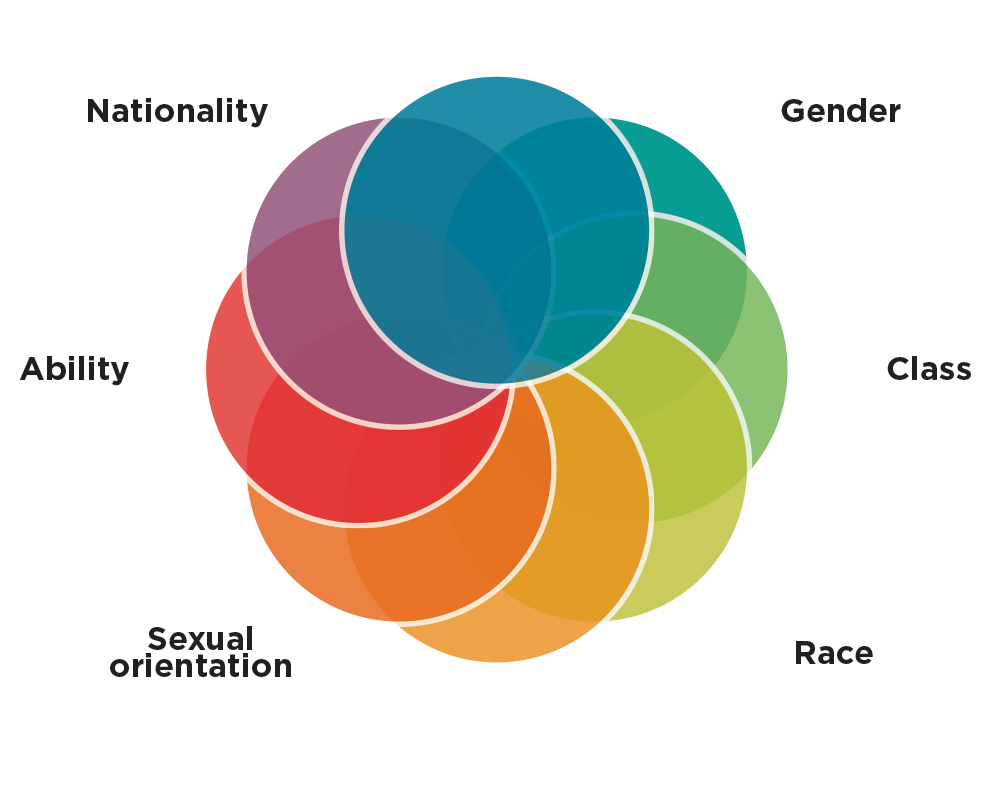
We must remember that identities do not exist in a vacuum and that all students have intersecting identities that can create even greater health inequity.
For example, 47% of transgender people are sexually assaulted at some point in their lifetime. Among transgender people of color, American Indian (65%), multiracial (59%), Middle Eastern (58%) and Black (53%) respondents of the 2015 U.S. Transgender Survey were most likely to have been sexually assaulted in their lifetime.
Data Briefs
Click on a brief below for more information.
Volume 8
Volume 7
Volume 6
Volume 5
Volume 4
Volume 3
Volume 2
Volume 1
Best Practices
Health Equity
- Health Equity and Prevention Primer: preventioninstitute.org/tools/tools-general/health-equity-toolkit
- 3 Things to Know: Health Equity: hogg.utexas.edu/3-things-to-know-health-equity
Cultural Competence*
- SAMHSA Cultural Competency Resources: samhsa.gov/section-223/cultural-competency/resources
- SAMHSA – TIP 59: Improving Cultural Competence: store.samhsa.gov/sites/default/files/d7/priv/sma14-4849.pdf
- Association of American Medical Colleges and the Association of Schools of Public Health - Cultural Competence Education for Students in Medicine and Public Health: s3.amazonaws.com/aspph-wp-production/app/uploads/2014/04/11-278-CulturCompet-Interactive-final.pdf
- A Prevention Guide to Improving Cultural Competency: pttcnetwork.org/centers/central-east-pttc/product/prevention-guide-improving-cultural-competency
*While cultural competence may be a starting place, the notion of ‘competence’ still centers around whiteness as the norm and a simple lack of knowledge about ‘other’ groups as the issue. This ignores the systemic problems that impact health inequity and implies passive learning as opposed to action.
Cultural Humility
- 3 Things to Know: Cultural Humility: hogg.utexas.edu/3-things-to-know-cultural-humility
- Practicing Cultural Humility to Transform Healthcare: rwjf.org/en/blog/2018/06/practicing-cultural-humility-to-transform-healthcare.html
- Cultural Humility is Critical to Health Equity: aafp.org/news/blogs/leadervoices/entry/20190418lv-humility.html
Trauma-Informed Care
Trauma-informed care and trauma-informed systems function according to at least four basic principles, often referred to as the “Four R’s.”
Recognize the signs and symptoms of trauma;
Respond by integrating knowledge about trauma into policies, procedures, and practices; and
Seek to actively Resist Re-traumatization
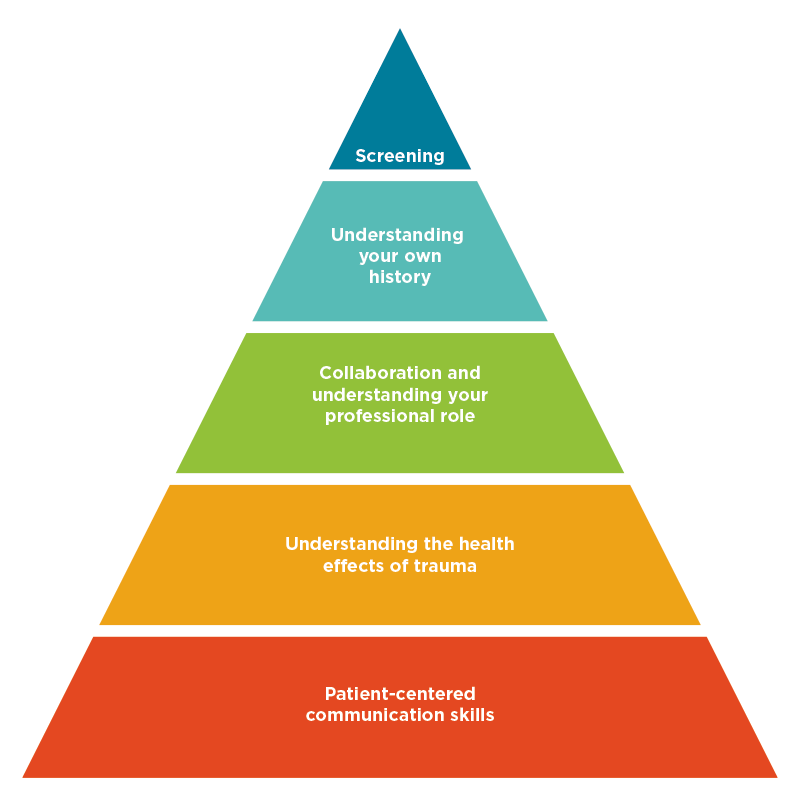
Trauma-informed care is an approach to engaging people with histories of trauma that recognizes the presence of trauma symptoms and acknowledges the role that trauma has played in their lives. The TIC pyramid (below) helps practitioners to visualize TIC and how to apply the principles to practice.
*From the Agency for Healthcare Research and Quality, Trauma-Informed Care*
- SAMHSA – TIP 57: Trauma-Informed Care in Behavioral Health Services: store.samhsa.gov/product/TIP-57-Trauma-Informed-Care-in-Behavioral-Health-Services/SMA14-4816
- Key Ingredients for Successful Trauma-Informed Care Implementation: samhsa.gov/sites/default/files/programs_campaigns/childrens_mental_health/atc-whitepaper-040616.pdf
- Trauma-Informed Approach to Prevention: kpfp.org/content/sites/kings/Local_Organizations/Trauma_Informed_Prevention.pdf
- 6 Guiding Principles to a Trauma-Informed approach: https://www.cdc.gov/cpr/infographics/6_principles_trauma_info.htm
Intersectionality
- An Intersectional Framework to Sexual Violence Prevention: insidehighered.com/advice/2017/09/01/sexual-violence-prevention-requires-focusing-how-multiple-forms-oppression
- Ten Tips for Putting Intersectionality into Practice: opportunityagenda.org/explore/resources-publications/ten-tips-putting-intersectionality-practice
- Ending Sexual Violence – An Intersectional Approach: calcasa.org/wp-content/uploads/2017/03/SAAM-2017-reduced-size-edited.pdf
- What is Intersectionality and Why Does it Matter? everfi.com/insights/blog/what-is-intersectionality-and-why-does-it-matter/
National Resources
- American College Health Association – Diversity and Cultural Competency: acha.org/ACHA/Resources/Topics/Diversity.aspx
- Centers for Disease Control – Cultural Competence: npin.cdc.gov/pages/cultural-competence
- Centers for Disease Control – Health Equity: cdc.gov/chronicdisease/healthequity
- Diversity Rx: diversityrx.org
- Prevention Technology Transfer Center Network – Building Health Equity and Inclusion: pttcnetwork.org/centers/global-pttc/cultural-responsiveness
- The Steve Fund: Achieving Equity in Mental Health: stevefund.org
- U.S. Department of Health and Human Services – Cultural Competence: hhs.gov/ash/oah/resources-and-training/tpp-and-paf-resources/cultural-competence
Students of Color
- BIPOC Mental Health Toolkit: mhanational.org/BIPOC-mental-health-month
Students with Disabilities
- Increasing Access to Treatment and Recovery Supports for People with Disabilities: c4innovates.com/brsstacs/DisabilityTipSheets/Disability_Tip_Sheet_Resources.pdf
Missouri Resources
- Missouri Coalition Against Domestic and Sexual Violence: mocadsv.org
- Missouri Department of Health and Senior Services: health.mo.gov
- Missouri Department of Mental Health: mdmh.mo.gov
- Missouri Foundation for Health: mffh.org
- Missouri Hospital Association – Health Equity: mhanet.com/quality-initiatives-health-equity.aspx
PIP Resources
- Check out our book list with topics on health equity, race and racism, and more
- Recommended Reading: The Opioid Crisis and the Black/African-American Community: An Urgent Issues
- Ask Listen Refer online suicide prevention training (special considerations for certain populations such as LGBTQ+, service members, etc.)
Research
Relevant Research Articles
- The Color of Drinking – University of Madison, Wisconsin
- Cultural Competence in Health Education and Health Promotion (2nd Edition)
- Expanding our Paradigms: Intersectional and Socioecological Approaches to Suicide Prevention
- The Impact of an Evidence-Based Cultural Competence Workshop for University Student Health Centers’ Licensed Personnel
- Incorporating intersectionality theory into population health research methodology: Challenges and the potential to advance health equity
- Intersecting Identities and Substance Use Problems: Sexual Orientation, Gender, Race, and Lifetime Substance Use Problems
- The Problem With the Phrase Women and Minorities: Intersectionality—an Important Theoretical Framework for Public Health
+ Click here for citations.
1. Mereish, E. H., & Bradford, J. B. (2014). Intersecting identities and substance use problems: sexual orientation, gender, race, and lifetime substance use problems. Journal of studies on alcohol and drugs, 75(1), 179–188. https://doi.org/10.15288/jsad.2014.75.179
2. Department of Justice, Office of Justice Programs, Bureau of Justice Statistics, Rape and Sexual Victimization Among College-Aged Females, 1995-2013 (2014).
3. David Cantor, Bonnie Fisher, Susan Chibnall, Reanna Townsend, et. al. Association of American Universities (AAU), Report on the AAU Campus Climate Survey on Sexual Assault and Sexual Misconduct (September 21, 2015). ("Victim services agency” is defined in this study as a “public or privately funded organization that provides victims with support and services to aid their recovery, offer protection, guide them through the criminal justice process, and assist with obtaining restitution.” RAINN presents this data for educational purposes only, and strongly recommends using the citations to review any and all sources for more information and detail.)
4. Department of Justice, Office of Justice Programs, Bureau of Justice Statistics, American Indians and Crime, 1992-2002 (2004).
5. 2017 Youth Risk Behavior Survey
6. American Foundation for Suicide Prevention, 2018
7. Douglas, K. R., Chan, G., Gelernter, J., Arias, A. J., Anton, R. F., Weiss, R. D., Brady, K., Poling, J., Farrer, L., & Kranzler, H. R. (2010). Adverse childhood events as risk factors for substance dependence: partial mediation by mood and anxiety disorders. Addictive behaviors, 35(1), 7–13. https://doi.org/10.1016/j.addbeh.2009.07.004
8. Washington, R., Marconi, A., Reeves, M., Jardas, E., The Color of Drinking – An exploratory study of the impact of UW–Madison’s alcohol culture on students of color (2018).
9. National Intimate Partner and Sexual Violence Survey, Centers for Disease Control (2010).
10. Centers for Disease Control, Vital Signs. Adverse Childhood Experiences (2019).
11. National Veterans Foundation, Troubling Veteran Mental Health Facts and Statistics that Need to be Addressed (2016).
12. U.S. Department of Veterans Affairs, Women Veterans Health Care (2020).
13. 2016 – 2020 DoD SAPRO Report
14. Pedro et al. - Journal of School Health - 2017Substance Use Among Transgender Students in California Public Middle and High Schools.
15. CDC. (2016). Sexual Identity, Sex of Sexual Contacts, and Health-Risk Behaviors Among Students in Grades 9-12: Youth Risk Behavior Surveillance. Atlanta, GA: U.S. Department of Health and Human Services.
16. National Alliance on Mental Illness – LGBTQ+ (2019)
17. Drug and Alcohol Awareness for International Students, (2018).
18. International Student Well-being, Inside Higher Ed (2019).
19. Addiction Center, Disability and Addiction (2020).
20. National Coalition Against Domestic Violence, Domestic Violence and People with Disabilities: What to Know, Why It Matters, and How to Help (2018).
21. Thompson, K. Depression and Disability, A Practical Guide (
22. Attempted suicide rates much higher in adults with learning disabilities, Healio (2017)
23. Karriker-Jaffe K. J. (2013). Neighborhood socioeconomic status and substance use by U.S. adults. Drug and alcohol dependence, 133(1), 212–221. https://doi.org/10.1016/j.drugalcdep.2013.04.033
24. Reiss F. Socioeconomic inequalities and mental health problems in children and adolescents: A systematic review. Soc Sci Med. 2013;90: 24–31. pmid:23746605
25. American Psychological Association, Violence and Socioeconomic Status (2010).
26. Brawner, R. (2015) Alcohol Abuse, Why Not an Issue for African American College Students?
27. Healthy Minds Study, 2018
